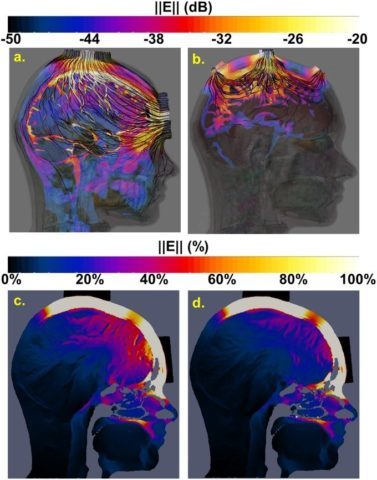
tACS, transcranial alternating current stimulation, involves using two or more electrodes to send sinusoidal waveforms of electricity onto certain positions of the skull in the hopes that it will change brain function. Some frequencies may need to be combined to get the right effects. Read this post to learn more about the potential benefits and drawbacks of tACS.
tACS Brain Stimulation
EEGs (electroencephalography; brain voltage readers) commonly use a Fourier Transformation to convert linear-time sequences of voltage changes in the brain to the domain of frequencies. This is where we get alpha (8-12.5 Hz) for drowsiness, beta (12.5-30 Hz) for alertness, theta (4-7 Hz) for early NREM sleep, and delta (0.1-3 Hz) for deep NREM sleep.
While theta and delta brainwaves are increased by alcohol, beta brainwaves can be increased with LSD, mescaline, and psilocybin [1, 2].
In the human brain, there are frequency bands that correspond to ultradian rhythm, a cycle of states of consciousness each with dominant brainwaves. The brainwaves cycle from rest to rest every 100 minutes (with activity between) and from wakefulness to wakefulness every three to eight hours (with drowsiness between) [3].
Recording and analyzing our own brain signals has the potential to help us schedule our work life on cycles of states of consciousness. This may allow us to work harder in wakeful activity states and take short breaks in resting states and long breaks in resting drowsy states.
Snapshot
Proponents
- May improve memory and learning
- Preliminary research suggests it may help with other cognitive functions, pain, schizophrenia, anxiety, withdrawal symptoms, and brain tumors
Skeptics
- Insufficient evidence for most benefits
- Relatively unknown safety profile
- Some adverse effects reported
- May increase risk-taking
Health Benefits of tACS
Possibly Effective
Memory and Learning
Using theta waves on the left parietal area, tACS increased working memory as well as factual memory (or declarative) in 4 clinical trials on 84 healthy people and 12 children with ADHD [4, 5, 6, 7].
However, this only worked when the theta waves were synchronized (phase-locked) in 2 clinical trials on 28 healthy volunteers [8, 9].
tACS may also increase memory confidence, as seen in a small trial on 12 healthy women [5].
In another trial on 18 healthy people, gamma-tACS improved working memory better than tDCS (transcranial direct current stimulation) and sham [10].
By using 6 Hz waves on the frontal cortex, tACS improved learning rate in a clinical trial on 50 healthy volunteers [11].
With the same frequency on the temporoparietal cortex, tACS improved learning new words for 12 older adults [12].
All in all, limited evidence suggests that tACS may help with memory and learning. Further research is needed to determine how to use it therapeutically.
Insufficient Evidence17
The following purported benefits of tACS are only supported by limited, low-quality clinical studies on small populations. There is insufficient evidence to support the use of tACS for any of the below-listed uses until larger, more robust clinical trials are carried out.
1) Changing Brainwaves
As found in 3 different studies on 46 healthy volunteers, tACS significantly increased brainwave power for 30 minutes in the wavelength range used to stimulate the brain after 20 minutes of stimulation [13, 14, 15].
With alpha waves (10 Hz), however, it only worked with eyes closed in 2 experiments on 54 healthy people [16].
2) Vision
tACS at 60 Hz on the visual cortex improved contrast detection in a clinical trial on 12 healthy people [17].
tACS on the parieto-occipital cortex at 10 Hz improved object detection in another trial on 14 people [18].
Gamma-range tACS improves vertical motion detection if it’s placed in the right area according to a test with 45 healthy volunteers [19].
3) Movement
Gamma tACS improved movement, but beta tACS worsened it, in a clinical trial on 18 healthy volunteers [20].
With 50 Hz, tACS improved motor function in a clinical trial on 15 healthy right-handers [21].
tACS also increased hand-eye coordination at 80 Hz according to a clinical trial on 14 people [22].
4) Reaction Times
tACS using 10 Hz on the primary motor cortex improved reaction time in 2 clinical trials on 28 healthy volunteers [23, 24].
Similarly, 40 Hz applied on the right parietal lobe improved conscious reaction time in another trial on 23 healthy right-handed young adults [25].
5) Hearing
In a study on 9 healthy volunteers, tACS using 35 Hz on the dorsolateral prefrontal cortex improved pitch memory [26].
tACS improved hearing the frequency used for stimulation in another trial on 14 healthy volunteers [27].
As found by a study on 21 healthy humans using 40 Hz on the temples, tACS improved speech perception, thus having a potential for helping dyslexics and learning a new language [28].
6) Pain
In a clinical trial on 30 people with spinal cord injury, tACS (with a 50 Hz signal) significantly reduced pain [29].
tACS also reduced pain perception in another trial on 23 healthy people, but only when its intensity was unexpected [30].
4 Hz produced pain relief through the mu opioid receptors (acute/cannabidiol and morphine) while 100 Hz acted through the delta opioid receptor (chronic/cannabidiol) in three animal studies [31, 32, 33, 34, 35].
At 4 Hz and 100 Hz, tACS reduced pain in mice through alpha 2A adrenaline receptors (the type of pain ignored in fight-or-flight mode) [36].
7) Improving Neurochemistry
With square waves of 100 Hz put through the earlobes of 38 healthy volunteers, tACS according to a review increased serotonin, beta-endorphin, ACTH, GABA, DHEA, and decreased tryptophan and cortisol in the blood after 20 minutes of stimulation. This suggests tACS might help insomnia and depression [37].
When 15 and 500 Hz were used in 13 healthy volunteers, tACS changed the same neurochemistry corresponding to improvements in symptoms of pain, insomnia, spasticity, depression and headache [38].
Noradrenaline was also reduced by 200 Hz in rats [39].
8) Reasoning
With gamma waves on the left middle frontal gyrus, tACS improved abstract reasoning and logical reasoning in a clinical trial on 20 right-handed people [40].
With theta waves applied to the left parietal area, tACS improved intelligence to solve new problems in another trial on 28 right-handed humans [41].
9) Schizophrenia
With 0.5 Hz and 100 Hz put through the earlobes, tACS helped patients with schizophrenia to have significantly less aggression. They also needed less medication and were restrained less, in a study performed on 9 people [42].
Also, with 4.5 Hz on the dorsolateral prefrontal cortex, tACS improved negative symptoms of schizophrenia in 3 patients [43].
With 10 Hz, tACS reduced hearing hallucinations and restored normal alpha wave oscillations in a clinical trial on 22 people [44, 45].
However, gamma-tACS had no effect on working memory in another trial on 10 people with schizophrenia [46].
10) Drug and Alcohol Withdrawal
In a clinical trial on 21 patients that were on a five-day washout from benzodiazepines, with a signal of 350 Hz, tACS significantly reduced anxiety and insomnia [47].
In a clinical trial on 20 patients that were abstinent for around three weeks, with 70 – 80 Hz square wave pulses, tACS increased MAO-B and GABA, thus increasing resistance to stress and anxiety [48, 49, 50].
11) Tremors
In only 30 seconds with a phase-locking feature, tACS stopped tremors in 12 patients with Parkinson’s; the average patient had a 50% reduction in tremor strength [51].
tACS may also stop tremors in healthy volunteers, as seen in a clinical trial on 23 people. However, only a certain montage type (with extracephalic return contralateral to the primary stimulating electrode) significantly reduced tremors in another trial on 12 healthy volunteers [52, 53].
12) Lucid Dreams
At 25 and 40 Hz of tACS stimulation, people were sent into a lucid dream for 58% and 77% of the time, respectively, in a clinical trial on 27 healthy volunteers [54].
13) Mental Imaging
At 8-11 Hz, tACS prolonged alpha waves in a clinical trial on 23 healthy volunteers. Prolonged alpha waves were associated with a continued increase in mental imaging (visualization performance) [55].
14) Strength
tACS significantly increased muscle power per distance (force per second) when used at 70 Hz in a clinical trial on 18 healthy people [56].
15) Anxiety
In a clinical trial on 12 people with generalized anxiety disorder, tACS at 0.5 Hz and 0.3mA lowered anxiety [57].
16) Brain Tumors
tACS allowed brain tumor patients to live twice as long (median) in a pilot clinical trial on 10 humans. Electric fields also inhibited tumor growth in mice and cell division in cancer cells [58].
tACS Combined with tDCS
Using tDCS of 1mA combined with tACS 0.425 mA of 10 Hz on 20 healthy right-handed volunteers, the phase of the electricity altered their ability to detect sound with a reference phase. This suggests its potential to develop devices that create artificial silence by canceling out surrounding hums [59].
tACS significantly lowered alpha waves (drowsiness) in the occipital lobe (responsible for vision) when placed on the forehead (cathode) and behind the ears (anode) at 70-80 Hz pulsed square waves in a clinical trial on 20 healthy people [60].
Health Risks of tACS
Keep in mind that the safety profile of tACS is relatively unknown, given the lack of well-designed clinical studies. The list of side effects below is not a definite one and you should consult your doctor about other potential side effects based on your health condition and possible drug or supplement interactions.
Some people got red and dry skin after using tACS [58].
Some people also got vertigo, nausea, anger, a metallic taste, a heavy feeling, or intense ear ringing, although 94% felt no negative side effects [37].
So far, no one has experienced memory loss; tACS can’t help hypnotism [37].
Slowing Movement
Both 10Hz and 20Hz on the left primary motor cortex with tACS significantly slowed finger tapping in a clinical trial on 15 people. 10 Hz took 30 minutes to slow it significantly, and 20 Hz slowed it immediately [61].
Triggering Tingle Feeling (Pins and Needles)
With alpha and high gamma frequency ranges, tACS created a sensation of pins and needles, a tingling without pain, in a clinical trial on 14 healthy volunteers [62].
Triggering Flashing Light (Phosphenes)
Seeing phosphenes is a hallucination consisting of seeing light without any light entering the eye.
tACS triggered flickering light with stimulation in the beta range in a light room and with stimulation in the alpha range in a dark room in a small trial on 8 healthy people [63].
Increasing Risk-Taking
With theta waves on the left dorsolateral prefrontal cortex, tACS increased riskier decision-making in a clinical trial on 27 healthy volunteers [64].


